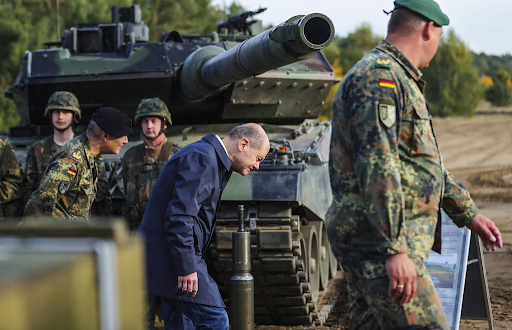German Chancellor Scholz Sending Leopard 2 Tanks to Ukraine: Germany’s Past and Present
Chancellor Olaf Scholz passes under the gun barrel of a Leopard 2 tank. Source for photo: Politico.
As Russia’s invasion continues, Ukraine has persistently called for an extensive supply of military equipment, especially from NATO countries. This request has been granted by countries like Canada and Great Britain. Ukraine has also been able to capture hundreds of Russian tanks along with other military equipment but is unable to use them immediately due to a need for repairs. Despite having these military resources, the amount of weapons Ukraine currently holds cannot last for the anticipated duration of this conflict, something that President Volodymyr Zelenkskyy and his government are all too aware of. Ukraine has long sought Germany’s Leopard 2 tanks to help in their fight against Russia. Now, Chancellor Olaf Scholz recently agreed to this request. While Ukraine will finally be getting the tanks it needs for a renewed offensive, it is important to recognize the events that led up to Germany ultimately changing its mind, and the significance of the country doing so.
A large part of Germany’s hesitation to commit weapons like the Leopard 2 tanks stems back to a haunting history of aggression during World War II. It is not just a concern of the German government, but of the general public as well, with only 46% of Germans in favor of sending Leopard 2 tanks to Ukraine. The image of German tanks being used to fight Russian soldiers evokes an image of a part of Germany’s past that they would like to avoid repeating. Another concern was the possibility of sparking Russian escalation of some form. Access to Leopard 2 tanks, specifically, is important to Ukraine because other modern tanks are considered “not sufficient to achieve operational goals,” according to a statement from the Ministry of Defense of Ukraine. It will take approximately two months for the tanks to get to Ukraine, during which Ukrainian soldiers will go through a six-week training program, as part of Europe’s pledge to deploy weapons rapidly to Ukraine. While Germany has fully supported Ukraine from a financial standpoint, there is a continual aversion to sending weapons, which makes the recent decision to send the Leopard 2 tanks a significant one. President Zelenskyy praised the move, stating that the tanks from Germany and other Western countries will be a “fist of freedom” in fighting back against Russia.
Poland and other European allies have been pushing for Chancellor Scholz to make this decision. A German decision is necessary because the Leopard tanks are manufactured in Germany, and other European countries in possession of Leopard 2 tanks require the permission of Germany to re-export them to Ukraine. The decision for Germany to send tanks is not just notable for the country as an independent entity, but for Western support of Ukraine as a whole, as it has opened the door for other countries to send their Leopard 2 tanks as well.
Germany is not the only powerful country who has reservations about sending tanks to Ukraine, as the U.S. holds some hesitation as well. Only when Germany announced the decision to send the Leopard 2 tanks did President Joe Biden declare that the U.S. would send M1 Abrams tanks to Ukraine, which will require a much longer term commitment due to logistical reasons. In a speech at the White House, President Biden proclaimed “Putin expected Europe and the United States to weaken our resolve…These tanks are further evidence of our enduring, unflagging commitment to Ukraine and our confidence in the skill of Ukrainian forces.” The hope is that this new wave of military assistance will help push back against Russia’s advancements in the eastern part of the country, and ultimately help Ukraine retain its sovereignty against a tyrannical enemy.

